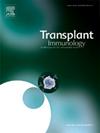Effect of maintenance immunosuppressive therapy on FoxP3 and CD28 gene expression in low risk kidney transplant recipients
IF 1.4
4区 医学
Q4 IMMUNOLOGY
引用次数: 0
Abstract
Background
FoxP3 is a transcription factor expressed by regulatory T cells and is essential for their development and suppressive function. CD28 is a costimulatory receptor on T cells that binds to CD80 and CD86 on antigen-presenting cells, providing a signal required for T cell activation and survival. This study compared FoxP3 and CD28 gene expression in kidney transplant recipients (KTR) maintained on immunosuppressive therapy with mammalian target of rapamycin inhibitors (mTORI) versus calcineurin inhibitors (CNI).
Methods
The expression of FoxP3 and CD28 was assessed in immunologically low-risk KTR with stable graft function. KTR receiving CNI (n = 24) were compared with those who underwent early conversion to mTORI post-transplant (n = 20). All patients received a transplant from living donors and the median time since transplant was 60 months. Gene expression analysis was performed in the peripheral blood mononuclear cells by quantitative PCR.
Results
FoxP3 expression differed significantly between treatment groups, with higher levels observed in the mTORI group compared to the CNI group (P = 0.025), while CD28 expression was comparable between groups. Among KTR receiving CNI therapy, FoxP3 expression was significantly lower in female recipients compared to males (P = 0.008); this difference was not observed in the mTORI group. In a multivariate analysis including age, sex, FoxP3 expression and immunosuppressive therapy, only mTORI therapy was significantly associated with higher estimated glomerular filtration rate [β = 22.66 (95 % CI = 3.41–41.91), P = 0.022].
Conclusions
In stable KTR, long-term immunosuppression with mTORI is associated with higher FoxP3 expression and lower CD28 to FoxP3 expression ratio compared to CNI. Although FoxP3 expression differed between treatment groups, only mTORI therapy was independently associated with improved kidney function.
维持性免疫抑制治疗对低危肾移植受者FoxP3和CD28基因表达的影响
背景:FoxP3是调节性T细胞表达的转录因子,对T细胞的发育和抑制功能至关重要。CD28是T细胞上的共刺激受体,与抗原呈递细胞上的CD80和CD86结合,提供T细胞活化和存活所需的信号。本研究比较了长期肾移植受者(KTR)在哺乳动物靶向雷帕霉素抑制剂(mTORI)和钙调磷酸酶抑制剂(CNI)免疫抑制治疗下的FoxP3和CD28基因表达。方法:在移植功能稳定的免疫低危KTR中检测FoxP3和CD28的表达。接受CNI的KTR (n = 24)与移植后早期转换为mTORI的KTR (n = 20)进行比较。所有患者都接受了活体供体的移植,移植后的中位时间为60 个月。采用定量PCR方法对外周血单核细胞进行基因表达分析。结果:各治疗组间FoxP3表达差异有统计学意义,mTORI组FoxP3表达高于CNI组(P = 0.025),而CD28表达组间具有可比性。在接受CNI治疗的KTR患者中,女性患者FoxP3表达明显低于男性(P = 0.008);在mTORI组中没有观察到这种差异。在包括年龄、性别、FoxP3表达和免疫抑制治疗在内的多变量分析中,只有mTORI治疗与较高的肾小球滤过率有显著相关[β = 22.66(95 % CI = 3.41-41.91),P = 0.022]。结论:在稳定的KTR中,与CNI相比,mTORI长期免疫抑制与FoxP3表达升高和CD28 / FoxP3表达比降低相关。虽然FoxP3表达在治疗组之间存在差异,但只有mTORI治疗与肾功能改善独立相关。
本文章由计算机程序翻译,如有差异,请以英文原文为准。
求助全文
约1分钟内获得全文
求助全文
来源期刊

Transplant immunology
医学-免疫学
CiteScore
2.10
自引率
13.30%
发文量
198
审稿时长
48 days
期刊介绍:
Transplant Immunology will publish up-to-date information on all aspects of the broad field it encompasses. The journal will be directed at (basic) scientists, tissue typers, transplant physicians and surgeons, and research and data on all immunological aspects of organ-, tissue- and (haematopoietic) stem cell transplantation are of potential interest to the readers of Transplant Immunology. Original papers, Review articles and Hypotheses will be considered for publication and submitted manuscripts will be rapidly peer-reviewed and published. They will be judged on the basis of scientific merit, originality, timeliness and quality.
 求助内容:
求助内容: 应助结果提醒方式:
应助结果提醒方式:


